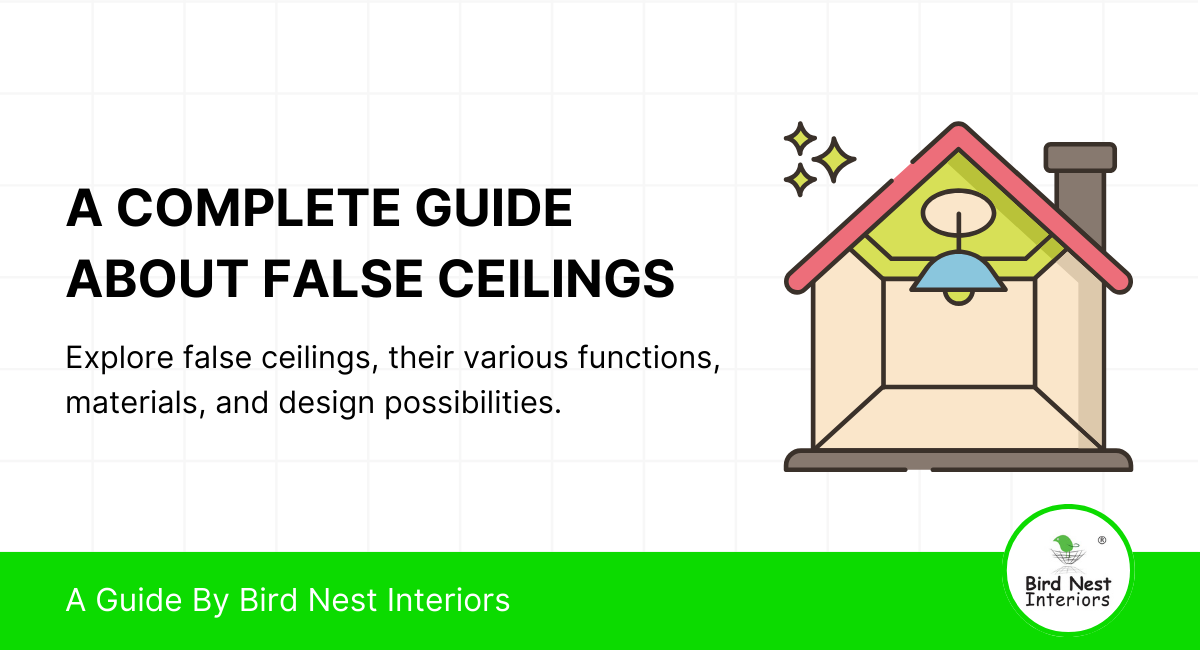While plain ceilings are perfectly functional, a whole world of design and practicality is waiting above you with false ceilings.
These suspended systems offer numerous benefits, from hiding unsightly elements to enhancing a room’s aesthetics.
Whether you’re renovating your home or revamping your office space, false ceilings deserve a closer look.
This article will explore false ceilings, their various functions, materials, and design possibilities.
Get ready to discover how a false ceiling can transform your space. Also, we would help you choose the right false ceiling type to start your design journey.
So, let us get started:
Types of False Ceilings
False ceilings offer a great way to enhance the aesthetics and functionality of a space. In India, several popular options cater to different design needs and budgets. Here’s a look at some commonly used false ceiling types:
1. Plaster of Paris (POP) False Ceilings:
POP false ceilings are made from Plaster of Paris powder mixed with water and applied over a metal mesh frame. They allow for intricate and decorative designs.
Advantages
- Cost-effective
- Fire-resistant varieties available
- Versatile for various designs and mouldings
- Easy to repair cracks or minor damages
Disadvantages
- Prone to moisture damage and sagging over time
- Limited soundproofing capabilities
- Installation can be messy
- Not very durable compared to other options
2. Gypsum False Ceilings
Gypsum false ceilings are pre-fabricated panels made from compressed gypsum plaster. They offer a smooth and modern finish.
Advantages
- Fire-resistant
- Lightweight and easy to install
- Good sound insulation properties
- Moisture-resistant varieties available
Disadvantages
- It can be more expensive than POP ceilings
- Less versatile for intricate designs
- Requires a skilled professional for installation
- It might not be suitable for areas with high humidity
3. Wood False Ceilings
Wood false ceilings add a touch of luxury and warmth to a space. They come in various types of wood and finishes.
Advantages
- Aesthetically appealing and creates a sophisticated look
- Good sound and thermal insulation properties
- Eco-friendly option with sustainable wood choices
- It can be easily customized.
Disadvantages
- The most expensive option among common false ceilings
- Requires regular maintenance to prevent warping or termite infestation
- Not suitable for areas with high moisture
- Fire safety needs to be considered with proper treatment
4. Fibre False Ceilings
Fibre false ceilings or acoustic ceilings are made from compressed mineral fibres. They are ideal for soundproofing applications.
Advantages
- Excellent sound absorption properties
- Affordable and lightweight
- Easy to install and maintain
- Fire-resistant varieties available
Disadvantages
- Prone to moisture damage and sagging
- Limited design options compared to other materials
- It might not be the most aesthetically pleasing choice
- Lower durability compared to some options
5. Metal False Ceilings
Metal false ceilings are constructed from lightweight metals like aluminium or galvanized steel. They offer a sleek and modern look.
Advantages
- Highly durable and resistant to moisture, fire, and corrosion
- Easy to maintain and clear
- Lightweight and won’t add significant weight to the structure
- Panels can be easily removed to access utilities
Disadvantages
- It can be expensive depending on the type of metal
- Limited soundproofing capabilities
- It might appear cold or industrial in some settings
- Prone to dents and scratches
6. Glass False Ceilings
Glass false ceilings allow natural light to penetrate the space and create a sense of openness. They are often used in combination with other materials.
Advantage
- It creates a spacious and airy feel
- Allows natural light to enter the room
- Modern and visually striking aesthetic
- It can be combined with lighting effects for a unique look
Disadvantages
- The most expensive option on this list
- Requires a strong support structure for safety
- Limited soundproofing capabilities
- Prone to breakage and requires careful handling
7 Things To Consider While Getting Your False Ceilings Designed
False ceilings can add a whole new dimension to your space aesthetically and functionally.
But with various materials, designs, and considerations, planning your false ceiling can seem daunting.
Here are 7 key factors to keep in mind to ensure a flawless outcome:
1. Functionality vs. Aesthetics
Functionality: Consider the room’s purpose. Will the false ceiling house air conditioning ducts, electrical wiring, or fire sprinklers? Soundproofing might be a priority in a home theatre.
Aesthetics: Think about the overall design theme. Do you want a minimalist look with clean lines or a more ornate design with mouldings? Bird Nest Interiors, Bangalore’s leading interior design firm, can help you create mood boards and explore design options that complement your décor.
2. Material Selection
The right material plays a crucial role in both function and aesthetics. Here are some key considerations:
3. Budget
Plaster of Paris (POP) is a cost-effective choice, while wood or metal tends to be more expensive.
4. Moisture Resistance
Moisture-resistant materials like PVC or gypsum board are ideal for bathrooms or kitchens.
Durability: If you desire intricate designs, POP offers flexibility. However, for long-lasting strength, consider metal or wood.
Bird Nest Interiors’ design experts can advise you on material selection based on your needs and budget.
5. Lighting Integration
False ceilings offer a perfect opportunity to create a captivating play of light. Recessed spotlights, cove lighting, or even skylights can completely transform the ambience. Discuss your lighting goals with Bird Nest Interiors.
Their team can design a lighting scheme that complements your false ceiling design and sets your desired mood.
6. Room Height
Remember, false ceilings steal some vertical space. A simple, flat design might be best in a room with a low ceiling.
You can explore dropped sections or multi-level designs to create visual interest if you have a high ceiling. Bird Nest Interiors can assess your room dimensions and recommend a design that maintains a sense of spaciousness.
7. Maintenance Needs
Consider how easy it will be to access utilities hidden behind the false ceiling and how often it might need cleaning.
If necessary, opt for easily removable panels. Bird Nest Interiors can suggest materials and designs that are easy to maintain and ensure your false ceiling retains its beauty for years.
By considering these factors and collaborating with a professional false ceiling design firm like Bird Nest Interiors, you can ensure your false ceiling becomes a stunning and functional focal point.


1 thought on “A Complete Guide About False Ceilings”